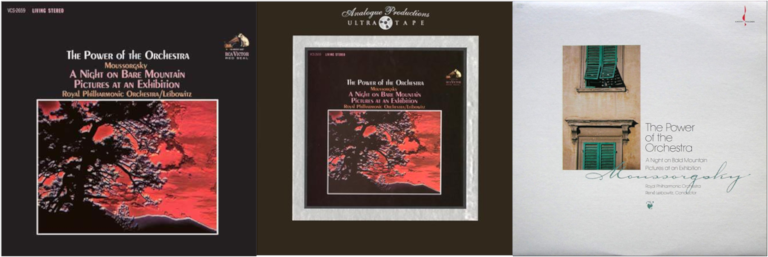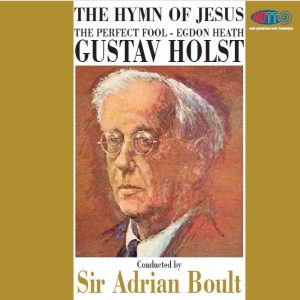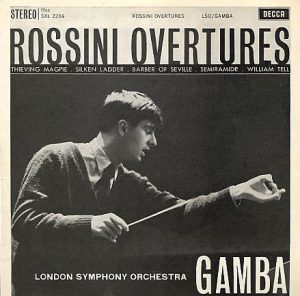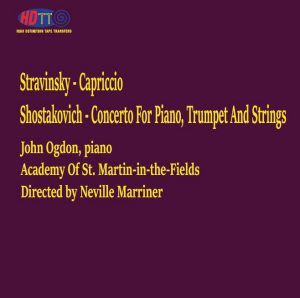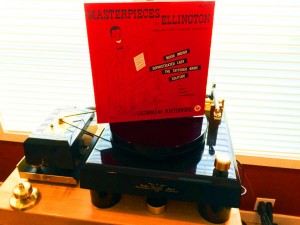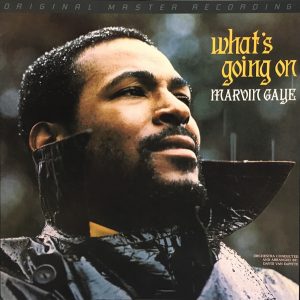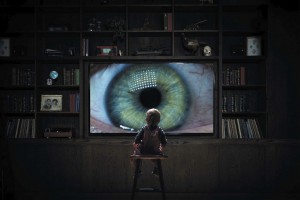Bob Witrak's High Definition Tape Transfers (HDTT) is a treasure house for DXD and DSD256 downloads of some of the best recordings from the golden age of analog stereo recording. Perusing the HDTT catalog is like traveling back in time to my favorite record store to wander through shelves of wonderful recordings from Decca, RCA, Mercury, Deutsche Grammophon, EMI, Capitol, Verve, and more. The depth and breadth of HDTT's offerings is simply amazing.
Given the loss of my LP collection a couple years ago, I have been gradually replacing some of my favorite LPs (collected very selectively over almost 50 years) with HDTT DSD256/DXD file downloads. There are so many superb performances in outstanding recordings that I rarely come away with just a few. And the occasional 20% off sales make purchases irresistible.
A couple of months ago, I shared with you a taste of some of the HDTT marvels you can add to your library—three recordings from the late 1950s with music by Stravinsky, Ravel, and Walton originally released on Westminster, RCA, and Decca.
Today, I invite you for a visit with several outstanding recordings made by the great Decca recording engineer Kenneth Wilkinson, one of my all-time heroes in audio. (Update: A later second article discussing even more recordings can be found here.)
Wilkinson had a tremendous talent for capturing the greatest possible truth of the sound of an orchestra performing in a natural acoustic environment and sharing that experience in two-channel playback as one might have heard it in the audience. He was also a perfectionist, and the results he frequently achieved over his career, when allowed to record as he thought best, are stunningly natural. His work for Decca in the late 1950s through early 1970s is legendary. But some of his greatest recordings were made under contract for issue by other than Decca.
Many of the great RCA Shaded Dog recordings, long listed in various "best of" LP listings over the years, were actually recorded under contract by Decca.* And many of those were Wilkinson recordings. A prime example is the revered two LP set, The Royal Ballet Gala Performances, by Ernest Ansermet and the Orchestra of the Royal Opera House, Covent Garden, released by RCA in 1959. I'll come back for a further discussion of this album, as available from HDTT, below.
Wilkinson was the engineer most responsible for Richard Itter's Lyrita recordings, which Decca produced. Itter always requested Wilkinson as engineer, calling him "a wizard with mikes". Not all of Lyrita's releases were recorded by Wilkinson, but his recording aesthetic is apparent in all of them. (For example, the famous Malcolm Arnold English, Scottish and Cornish Dances, SRCS 109 (1979), was recorded by Wilkinson protégée, John Dunkerley.)
And Wilkinson's stereo recordings produced with Charles Gerhardt for Readers Digest are masterpieces. The 12-LP box set released as Treasury of Great Music (RDS 5020-31, 1963 UK, 1964 US) is an example. Many of the recordings from this set have been reissued by Chesky and other audiophile labels. (Examples: Sibelius' Symphony No. 2 with Sir John Barbirolli; Bizet's Symphony in C with Charles Munch, coupled with Tchaikosky's Francesca Da Rimini.) The Nine Symphonies of Beethoven box set with René Leibowitz has also been highly regarded for both performances and sound quality.
A Wilkinson recording which I have long considered to be the most perfect capture in stereo of the natural sound of a full orchestra, is the excellent The Power of the Orchestra (1963) originally released by RCA and subsequently by Chesky and Analogue Productions. This recording with Rene Leibowitz conducting the Royal Philharmonic Orchestra includes Leibowitz' own orchestrations of Night on Bare Mountain, so it sounds rather different than we are used to hearing from the Rimsky-Korsakov orchestration. Chad Kassem must think as highly of this Wilkinson recording as do I because he's released it four separate times: 2x12" 45rpm vinyl in 2009; SACD in 2009; 2xReel tape in 2017; single LP in 2018. But, alas, no DSD256/DXD release anywhere. Hint, hint…
I don't know of a better way to sum up the contribution Kenneth Wilkinson made to stereo recording than the following appreciation written by Tam Henderson, Reference Recordings, upon Wilkinson being named recipient of the 2003 Walter Legge Award. Henderson writes:
"For much of his illustrious, half century career, recording engineer KENNETH WILKINSON labored in anonymity. It was only toward the end of the LP era that labels began to identify production teams, and even then in small type. However, his reputation among musicians, colleagues and audiophiles was supreme. At Decca/London during its golden age from the 1950s to his retirement in 1980, 'Wilkie' always headed The A Team.
"He was responsible for thousands of major orchestral recordings at Decca/London, also many operas and Britten's 'War Requiem' (of which he was especially proud). Still, he found time to do more, such as the highly-prized orchestral series for Reader's Digest, much of the Lyrita catalogue, and the path breaking series of film scores with Charles Gerhardt for RCA.
"The most remarkable sonic aspect of a Wilkinson orchestral recording is its rich balance, which gives full measure to the bottom octaves, and a palpable sense of the superior acoustics of the venues he favored, among them the Assembly Hall at Waltham Forest Town Hall, Walthamstow in London and The Kingsway Hall of revered memory."
—Classical Hall of Fame 2003 Award List, Audiophile Edition, July-August 2003
I highly encourage you to explore Wilkinson's legacy of recordings. Perhaps you'll become a similarly unabashed fan of his works. Currently, High Definition Tape Transfers has over 80 recordings engineered by Wilkinson in its catalog. You can take a look in this search link.
Original Decca and RCA covers courtesy of Discogs. All of these classic Wilkinson recordings, and more, are available from High Definition Tape Transfers in DXD/DSD256 downloads under different cover art.
For the balance of this article, I'd like to introduce you to just six jewels from the HDTT catalog as alternatives you might explore if the music appeals.
Jean Martinon Conducts Ibert, Saint Saens, Bizet, and Berlioz, Jean Martinon, Paris Conservatoire Orchestra. HDTT (1958, 1960 Decca (DXD) (HERE)
Recorded by Decca in 1958 but not released in stereo until 1960, this is an early Kenneth Wilkinson tour de force. For this recording, Wilkinson and his team are in the center of Paris at La Maison de la Chimie. Decca tended to send Wilkinson all over England and Europe to recording sessions during this period, and later to the U.S. While most recordings on the continent were engineered by Roy Wallace (with excellent results), and most of Wilkie's great recordings were made in England, there are Decca recordings like this one where Wilkie and his A Team come in to really make a great one.
Original Decca stereo cover from 1960.
Jean Martinon is known for his excellent recordings of the music of French composers. He was more versatile than this reputation suggests, but his performances here are clearly outstanding, perhaps definitive.
Buckle your seat belt and hold your hat with the launch of the first work: Ibert's Divertissement. Martinon takes the first movement faster than I've ever heard it, but then balances nicely with the varying tempi chosen in other portions of the composition—it all works together. Are you familiar with the collection of circus marches called "Screamers"? Well, that's what Divertissement always makes me think of. It is a work filled with rollicking fun in the first movement and finale, with more subtle sly humor filling out the middle movements. This music is, as Andrew Achenbach wrote, "an absolute hoot!"
Bizet's Jeux d'enfants (Children's Games) is an altogether more subtle, delicate piece of music, and is performed accordingly. Originally written as a suite of twelve pieces for piano four hands, Bizet orchestrated six of which we have five on this recording. Engagingly performed with great panache by Martinon and the Conservatoire.
The Saint-Saens works and the Berlioz overtures are finely wrought and enjoyable. Am I damning with faint praise? Not intended. Martinon's performance of Berlioz overtures are, as a reviewer once wrote, "personable and sparky renderings." But while they are nice, they are fairly mainstream interpretations and not the reason to add this album to your collection.
The reasons to add this album to your collection are the overall sound quality and the great fun Martinon has with the Ibert and Bizet. I enjoy the entire album immensely each time I play it.
Ansermet conducts Ballet Music with the The Orchestra Of The Royal Opera House, Covent Garden. HDTT (1959 RCA (DXD) (Part 1 HERE and Part 2 HERE)
This is the justly famous Royal Ballet Gala Performances under another title and with different cover art. Recorded by Decca for RCA in January 1959 with recording engineering by Kenneth Wilkinson, this is one of the more revered RCA Living Stereo releases.
Original RCA cover from 1959
There are two reasons this recording is so highly regarded: 1) superb performance by Ansermet and the Orchestra of the Royal Opera House, Covent Garden and 2) superb, translucent recording by the Decca recording team led by Kenneth Wilkinson and working with Decca producer Michael Williamson. And the sound quality of this DXD transfer by Bob Witrak is as good as anyone may hope for. It is open, dynamic, resolving, and lifelike. Just listen to the Chinese Dance, track 4, for a representative sample of this recording—a joy to hear.
Anthony Kershaw, writing about this recording in his survey of the original series of Classic Records reissues of the Living Stereo LPs for Audiophilia in 2016, says:
"This is the stuff of which dreams are made. The Royal Ballet Gala is one of the finest RCAs recorded in London's Kingsway Hall…Tonally, Messrs. Williamson and Wilkinson have used their considerable talents to capture the orchestra superbly. Woodwind and strings glow and resonate, transporting this listener to a time when simpler recording was better. Brass ring out thrillingly and percussion effects are very musical. Be it a bang, swish, rattle, crack or snap, each percussionist is situated perfectly within the beautiful Kingsway soundstage. Even the difficult-to-record sound of the celeste is captured in its purely mechanical form. Its delicate sound is heard to great effect during the Nutcracker—originating stage left, the sound decays across the stage of Kingsway with sparkling beauty. Wonderful."
I could not agree more, and could not describe it any better.
The bottom end is a bit warm and full sounding, but still with wonderful clarity and extension. Listen to the Coppélia "Introduction And Waltz," track 11, with the very soft, but deep, strummed double basses near the beginning and the forte passage toward the end in which the low brass and percussion roar forth. This was recorded with all tube electronics from the late 1950s, after all. And this is just as I've heard it on the best LP issues I've owned over the years. These LP issues included the remarkable 9-LP single sided 45-rpm box set reissue from Classic Records, HERE.
9-LP, single-sided, 45-rpm box set produced by Classic Records.
Does the HDTT transfer sound better? Hmmm, I can no longer compare them, and I am working from fallible aural memory, after all. It's perhaps not as finely resolved and detailed. Still, that's a high compliment since the lacquers for the Classic Records 45-rpm reissue were cut by Bernie Grundman from the original master tapes using his "post-Wilma-Cozart" updated tube mastering gear. The 5-LP box set that is still available from Analogue Productions uses the same metal work. So, if you have $150 available, go for it. Otherwise, get this marvelous release from HDTT in DXD for one-third the cost—seriously. I'm finding this transfer in DXD just as enjoyable in my current digital audio setup.
Wilkinson was clearly on his game for this recording in January 1959, with much more to come as he continued to refine his stereo recording technique. Remember, this was still early in Decca's learning process for recording in stereo. The mono recording teams had been at this game for years and had nailed their setup for every hall in which they recorded. Wilkinson had only moved to the stereo recording team full-time that year as it became clear that "Full Frequency Stereophonic Sound" was the future of Decca. The stereo team engineers were still experimenting with what mike placement would work best for stereo recordings in each given hall and experimenting with modifications to that famous "Decca Tree."
Kingsway Hall had been Decca's classical recording studio since it was originally leased by Decca in about 1926. Its notorious subway rumble didn't prevent it from being considered by many, including Wilkinson, to be the best recording studio in London. And this Royal Ballet Gala Performances recording certainly benefits from Kingsway's marvelous natural acoustics.
Gustav Holst: The Perfect Fool, Egdon Heath, The Hymn of Jesus, Adrian Boult, London Philharmonic Orchestra. HDTT (1961, 1962 Decca (DXD) (HERE)
I admit it—I'm a fan of Holst's music. I'm also a fan of British 20th Century composers overall. Gustav Holst wrote more than The Planets, and his other compositions can be a pure pleasure when well performed. The Perfect Fool and Egdon Heath fall well within this category of pure pleasure, and they are beautifully well performed here by Sir Adrian Boult and the London Philharmonic Orchestra. The Hymn of Jesus (1917) choral work may not translate so well for today's audience (Ann describes is as "a bit of a disjointed mess"), but with its echoes of the mystical effects found in Venus and Uranus in The Planets it is nonetheless quite appealing. It continues as one of Holst's most frequently performed works.
Regardless, with two-out-of-the-three being transcendent works for my pleasure senses, I'm very happy about this album.
The Perfect Fool (1922), a twelve-minute ballet, opens with a trombone entry and brass fanfares aligning to Uranus from The Planets. The instrumentation is vividly clear and exotic. Listen for the bassoon solo receiving answer from trombone, tuba, and the full complement of brass and strings, triple forte, as the performers build up to a full on pagan rite. The viola introduces a final section, pastoral and mystical, and the piece ends on a striking chord. It is said that Holst was never completely satisfied with this composition—he was being overly self-critical. It definitely works for me.
Egdon Heath (1927) is a grim and brutal piece of music celebrating the work of author Thomas Hardy, whose The Return of the Native met a resonant chord in Holst. It opens with a somber bass melody followed by oboe and strings flowing into a ghostly dance building towards a strong crescendo that then fades. The violas offer a kind of dirge answered by higher strings and brass. The work closes with a lonely trumpet call with only winds and strings in sad reply. All of which then fades into silence. The entire setting is unsettling, uneasy, but with a dark beauty.
All of this music is well captured by Kenneth Wilkinson's microphones in Kingsway Hall, London. This recording is a great introduction to the excellence of Kingsway Hall's acoustics and why it is such a legendary recording venue for both Decca and EMI.
Gioachino Rossini: Overtures, Pierino Gamba, London Symphony Orchestra. HDTT (1961 Decca (DXD) (HERE)
I can't begin to say for how many years this Decca recording lived in my listening room in its vinyl incarnation, regularly pulled out for visitors across several audiophile remasterings. Today, I am incredibly pleased to have it once more in my music library in this truly excellent transfer from HDTT. These are thrilling, highly regarded performances of the Overtures in another sonic masterpiece from Wilkinson and Decca.
Original Decca cover from 1961.
In a review of the XRCD reissue of this album some years ago, John J. Puccio comments in a way I find rather entertaining because it is so true: "After Victor Company of Japan (JVC) had remastered so many old recordings by Fritz Reiner and the Chicago Symphony, the first thing I wondered when I learned about this JVC release of Rossini overtures was why they had chosen Pierino Gamba's 1960 recording instead of Reiner's. After all, Reiner's performances of six popular Rossini overtures are among the best ever put to disc, sonically and interpretively. Then I listened to Gamba and remembered why they did it."
Yes, just listening to Gamba in these works gives one a complete understanding as to why, when Decca first released the LP, it hit the top recommendations in Gramophone, Stereo Review, the Penguin Guide, Fanfare, and many other magazines. Today you'll continue to find it on most of the "best of" lists.
Gamba's performances are crisp and unfussy, with a precision that pulls out details that are often glossed over in other performances. One could argue that his interpretations are a bit cool, but he creates a level of pure aliveness in some areas that is addictive to hear. These are as exciting performances as any available to us. Simply listen to the opening of La Gazza Ladra (The Thieving Magpie) and I rest my case.
Of course, beyond the pure performance excellence on this album, there is the pure joy of another wonderful Wilkinson recording effort. This time the recording was made in Walthamstow Assembly Hall, London. Walthamstow is a venue Wilkinson quickly located in 1946 when a series of sessions with Charles Munch couldn't be booked into Kingsway Hall. It has been the site of some of Wilkinson's (and Decca's) best recordings, including many produced with Charles Gerhardt.
Ernest Bloch: Schelomo and Voice in the Wilderness, Janos Starker, Zubin Mehta, Israel Philharmonic. HDTT (1970 Decca (DSD256) (HERE)
Ernest Bloch's Schelomo (1916) is a dramatic work—a meditation on King Solomon and all his glory, pain, and finally peace. Bloch roils our emotions, finally emerging to a vision of peace. Bloch always takes risks in his compositions; he doesn't play safe. He was a totally "no risk, no reward" kind of composer. And when the risks pay off, as here, you get to enjoy great music.
Written for cello and orchestra, this is not a concerto. It is a synthesis of the voice of the cello (Solomon) weaving in and through the various voices of the orchestra.
Janos Starker, one of the great cellists of the last century, plays this in a way I find very convincing. I always stay engaged with his performance in this work. As The Strad observes in a survey of the various cellists who have recorded this work, Starker "relishes the score's more heated moments with contagious zeal. For some tastes, the musical voltage setting may be set rather high, but for sheer excitement and intensity few other versions match this." For my tastes, he gets is just right. His trademark smooth, pure tones are a welcome relief to more nervous sounds from other cellists.
This release pairs with Schelomo Bloch's other major work for cello and orchestra, Voice in the Wilderness. And it is not to be overlooked. Walter Simmons writes, "…Voice in the Wilderness is often viewed as a sequel to Schelomo, from the vantage point of two decades later. The work consists of six orchestral episodes in Bloch's mature orchestral language–less ethnically specific, more concentrated rhetorically, but no less passionately expressive. Each episode is followed by a commentary by the cello that ruminates and elaborates upon the ideas expressed by the orchestra. The tutti episodes are brilliant, varied, and display Bloch's almost alchemical mastery of the orchestra…" And in this much of his commentary, I concur. This is a major orchestral work that is well worth knowing.
Original 1970 Decca cover.
And the recording, made by Wilkinson with producer Ray Minshull in June 1969 at Santa Cecilia, Rome, is yet another sonic jewel for Decca. Instruments are heard clearly and distinctly, with excellent presence and accuracy of timbre. The soundstage is broad and deep, with excellent rendering of instrument placement on stage. Percussion is deep, solid, and impactful. The low strings have a deep resonance that is delightful to hear. On a few of the large scale forte sections there is a bit of compression. But overall, this is as transparent and accurate a rendering of a large scale orchestral performance from the analog stereo era as one may hope to hear.
Shostakovich: Concerto for Piano, Trumpet and Strings; Stravinsky: Capriccio, John Ogdon, piano, Academy of St.-Martin-in-the-Field directed by Neville Marriner. HDTT (1970 Argo (DXD) (HERE)
One of my favorite albums (period). The Shostakovich in particular. Yes, the Stravinsky is just fine. But my heart is with the Shostakovich and the performance by the wonderful pianist, John Ogdon, playing here in his prime. The album was issued by Argo, a Decca subsidiary, and recorded by Kenneth Wilkinson for Argo in 1970.
Original 1970 Argo cover. John Wilbraham, trumpet, on the left. Neville Marriner in the center. John Ogdon on the right.
If you don't know some of the John Ogdon's performances, you can start right here. There are other good places to start, but this performance and the recording are just soooo good, I encourage you to give it a go. Plus, you'll hear some good trumpet playing by John Wilbraham (understatement!).
Scored for piano, trumpet, and string orchestra, Shostakovich's Concerto for Piano, Trumpet and Strings (also known as Piano Concerto No. 1) was premiered by the Leningrad Philharmonic, with Shostakovich himself as the soloist. It is a work that attracts both professional pianists and audiences with its technical virtuosity and energy.
You just know I have several different performances of this music—it's that good. But, this is my favorite. Ogdon's weighty and idiosyncratic playing captures a degree of interest that make other performances sound predictably straight forward and unimaginative. Plus, with this performance we have Wilbraham's marvelous trumpet performance. Wilbraham is so good in this music that I'd take the recording just for his trumpet. Ah, well. I'm more than happy to be doubly blessed here.
And let's not forget Wilkinson! Yes, this recording is here because it is another example of Wilkinson's excellent engineering. More microphones now (it's 1970 after all), but also more instrumental detail without feeling like it's being spot-miked to death. Did I say this was a favorite recording? Oh, yes—highly recommended for the music, performance, and sound quality.
Back to High Definition Tape Transfers… This article has been focused on the artistry of recording engineer Kenneth Wilkinson. But that subject, worthy as it is, was chosen to provide the vehicle to further introduce you to the joys of High Definition Tape Transfers' extensive catalog. We could as easily have chosen to talk about recordings made by Rudy Van Gelder for Blue Note Records, or the recordings of Count Basie, or the works by Leonard Bernstein—all of which and more are amply represented in the HDTT catalog. As I started this article by saying, HDTT is treasure house of marvelous recordings transferred to exceptional high resolution digital downloadable files. You can bet I will be coming back to discuss more recordings from HDTT in future articles.
Additional resources about the development of Decca Stereo recording… If you are interested in taking a deeper dive into the history of Decca and the development of the Decca Sound, here are three online resources that I've found useful over the years:
The Decca Sound: Secrets Of The Engineers
Michael H. Gray – The Birth of Decca Stereo
Decca Classical Discography, 1929-2009
*As previously mentioned, some of the great RCA titles were actually recorded under contract with Decca. Many of these have been praised as some of the greatest performances and recordings in the RCA catalog. Here are some of the many RCA titles recorded by Decca with Kenneth Wilkinson as the recording engineer:
- Royal Ballet Gala Performances, Ansermet, RCA LDS 6065
- Rachmaninov Symphony No. 3, Boult RCA LSC 2185
- Witches Brew, Gibson, RCA LSC 2225
- Prokofiev Symphony No 7, Martinon RCA LSC 2288
- Claire de Lune, Agoult, RCA LSC 2326
- Bizet L'Arlesienne Suites 1 and 2; Chabrier, Morel, RCA LSC 2327
- Ballet Music from the Opera, Fistoulari, RCA LSC 2400
- Elgar Enigma Variations, Monteux, RCA LSC 2418
- Dvorak Slavonic Dances, Martinon, RCA LSC 2419
- Gounod Faust, Gibson, RCA LSC 2449
- Dvorak Symphony No. 2, Monteux, RCA LSC 2489
- Chopin Piano Concerto No. 1, Rubinstein, LSC 2575
- Vieuxtemps Violin Concerto No. 5, Heifetz, RCA LSC 2603
- Bruch Violin Concerto No. 1, Heifetz, LSC 2652
- Rachmaninov Symphony No. 2, Previn RCA LSC 2899
- Nielsen Symphony No. 1, Previn RCA LSC 2961
- Vaughan WIlliams Symphonies 1-7, Previn RCA LSC 3170, 3282, 3178, 3224, 3066
- Korngold Sea Hawk, Gerhardt, RCA LSC 3330
- Borodin Complete Orchestral Music, Tjeknavorian, RCA CRL3 2790
- Power of the Orchestra, Leibowitz, RCA VICS 2659
Images of historical covers courtesy of Discogs. Other images courtesy of the respective labels.







